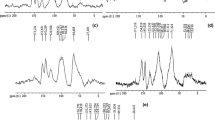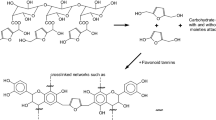Abstract
Mixed interior wood panel tannin adhesive formulations were developed in which lignin is in considerable proportion, 50%, of the wood panel binder and in which no “fortification” with synthetic resins, such as isocyanates and phenol-formaldehyde resins as used in the past, was necessary to obtain results satisfying relevant standards. A low molecular mass lignin obtained industrially by formic acid/acetic acid pulping of wheat straw was used. Environment-friendly, non-toxic polymeric materials of natural origin constitute up to 94% of the total panel binder. The wood panel itself is constituted of 99.5% natural materials, the 0.5% balance being composed of glyoxal, a non-toxic and non-volatile aldehyde, and of hexamine already accepted as a non-formaldehyde-yielding compound when in presence of condensed tannin. Both particleboard and two types of plywood were shown to pass the relevant interior standards with such adhesive formulations. Moreover, the much cheaper non-purified organosolv lignin showed the same level of results as the more expensive purified type.
Zusammenfassung
Es wurden verschiedene Tannin-Klebstoff-Rezepturen mit einem hohen Ligninanteil von 50% für plattenförmige Holzwerkstoffe für den Innenbereich entwickelt. Dabei konnte auf eine „Verstärkung“ mit Kunstharzen, wie zum Beispiel Isocyanaten und Phenolformaldehyd, wie sie bisher zur Erfüllung der Anforderung relevanter Normen erforderlich war, verzichtet werden. Verwendet wurde ein niedermolekulares Lignin, das industriell durch Ameisensäure-/Essigsäureaufschluss von Weizenstroh gewonnen wurde. Umweltfreundliche, ungiftige polymerische Stoffe natürlichen Ursprungs machen bis zu 94% des gesamten Bindemittels aus. Die Holzplatte selber besteht zu 99,5% aus natürlichen Materialien und zu 0,5% aus Glyoxal, einem nicht toxischen und nicht flüchtigen Aldehyd, sowie aus Hexamin, das in Verbindung mit kondensiertem Tannin als nicht Formaldehyd emittierende Substanz gilt. Es wurde gezeigt, dass sowohl eine Spanplatte als auch zwei Sperrholzarten, die unter Verwendung dieser Rezepturen hergestellt wurden, entsprechende Normen für Platten zur Verwendung im Innenbereich erfüllten. Zudem führte das wesentlich billigere, ungereinigte Organosolv-Lignin zu gleichen Ergebnissen wie der viel teurere, gereinigte Typ.




Similar content being viewed by others
References
Amaral-Labat GA, Pizzi A, Goncalves AR, Celzard A, Rigolet S (2008) Environment-friendly soy flour-based resins without formaldehyde. J Appl Polym Sci 108:624–632
Avignon G, Delmas M (2000) Method for producing paper pulp, lignins, sugars and acetic acid by frantionation of lignocellulosic vegetable material in formic/acetic acid medium. US patent 7,402,224
Ballerini A, Despres A, Pizzi A (2005) Non-toxic, zero-emission tannin-glyoxal adhesives for wood panels. Holz Roh Werkst 63:477–478
Despres A, Pizzi A (2006) Colloidal aggregation of aminoplastic polycondensation resins: UF vs. MF and MUF resins. J Appl Polym Sci 100:1406–1412
El Mansouri N-E, Pizzi A, Salvado’ J (2007) Lignin-based wood panel adhesives without formaldehyde. Holz Roh Werkst 65:65–70
EN 312 (1995) Wood particleboard—specifications
EN 314-2 (1993) Plywood—specifications
Fengel D, Wegener G (1983) Wood: chemistry, ultrastructure, reactions. De Gruyter, Berlin
Hillis WE, Urbach G (1959) Reaction of polyphenols with formaldehyde. J Appl Chem 9:665–673
JIS A5908 (1994) Particleboards, Japanese Standards Assoc, Tokyo, Japan
Kamoun C, Pizzi A (2000a) Mechanism of hexamine as a non-aldehyde polycondensation hardener, part 1: mechanisms. Holzforsch Holzverwert 52:16–19
Kamoun C, Pizzi A (2000b) Mechanism of hexamine as a non-aldehyde polycondensation hardener, part 2: recomposition of intermediate reactive compound. Holzforsch Holzverwert 52:66–67
Kamoun C, Pizzi A, Garcia R (1998) The effect of humidity on cross-linked and entanglement networking of formaldehyde-based wood adhesives. Holz Roh Werkst 56:235–243
Kamoun C, Pizzi A, Zanetti M (2003) Upgrasing of MUF resins by buffering additives, part 1: hexamine sulphate effect and its limits. J Appl Polym Sci 90(1):203–214
Lei H, Pizzi A, Du G (2008) Environment-friendly, mixed tannin/lignin wood resins. J Appl Polym Sci 107:203–209
Lorenz L, Frihart CR, Wescott JM (2006) Analysis of soy flour/phenol-formaldehyde adhesives for bonding wood. In: Proceedings wood adhesives 2005. Forest Products Society, Madison, pp 501–506
NIOSH (2000) National Institute for Occupational Safety and Health. The registry of toxic effects of chemical substances, December 2000
Pichelin F, Nakatani M, Pizzi A, Wieland S, Despres A, Rigolet S (2006) Thick wood panels bonded industrially with formaldehyde free tannin adhesives. For Prod J 56:31–36
Pizzi A (1978) Tannin formaldehyde exterior wood adhesives through flavonoid B-ring cross-linking. J Appl Polym Sci 22:2397–2399
Pizzi A (2006) Developments in biobased adhesives for wood bonding: opportunities and issues. J Adhes Sci Technol 20:829–846
Pizzi A, Stephanou A (1993a) Rapid curing lignins-based exterior wood adhesives, part 1: diisocyanates reaction mechanisms and application to panel products. Holzforschung 47:439–445
Pizzi A, Stephanou A (1993b) Rapid curing lignins-based exterior wood adhesives, part 2: Acceleration mechanisms and application to panel products. Holzforschung 47:501–506
Pizzi A, Beaujean M, Zhao C, Properzi M, Huang Z (2003) Acetals-induced strength increase and lower resin contents in MUF and PF wood adhesives. Holz Roh Werkst 61:419–422
Roux D (1976) Wattle bark and Mimosa extract. Leather Industries Research Institute, Grahamstown
Stiasny E (1905a) The action of formaldehyde on the tannins. Der Gerber 740:186
Stiasny E (1905b) The action of formaldehyde on the tannins. Der Gerber 775:347
Suomi-Lindberg L (1985) Bark extracts and their use in plywood bonding. Pap Puu 67(2):65–69
Theis M, Grohe B (2002) Biodegradable lightweight construction boards based on tannin/hexamine bonded hemp shaves. Holz Roh Werkst 60:291–296
Wescott JM, Frihart CR, Lorenz L (2006) Durable soy-based adhesive dispersions. In: Proceedings wood adhesives 2005. Forest Products Society, Madison, pp 263–270
Zakis GF (1994) Functional analysis of lignins and their derivatives, Tappi, p 65
Zanetti M, Pizzi A, Faucher P (2004) Low-volatility acetals to upgrade the performance of MUF wood adhesives. J Appl Polym Sci 92:672–675
Zhao C, Pizzi A, Kühn A, Garnier S (1999) Fast advancement and hardening acceleration of low condensation alkaline PF resins by esters and copolymerized urea. J Appl Polym Sci 74:359–378
Author information
Authors and Affiliations
Corresponding author
Rights and permissions
About this article
Cite this article
Mansouri, H.R., Navarrete, P., Pizzi, A. et al. Synthetic-resin-free wood panel adhesives from mixed low molecular mass lignin and tannin. Eur. J. Wood Prod. 69, 221–229 (2011). https://doi.org/10.1007/s00107-010-0423-0
Received:
Published:
Issue Date:
DOI: https://doi.org/10.1007/s00107-010-0423-0




